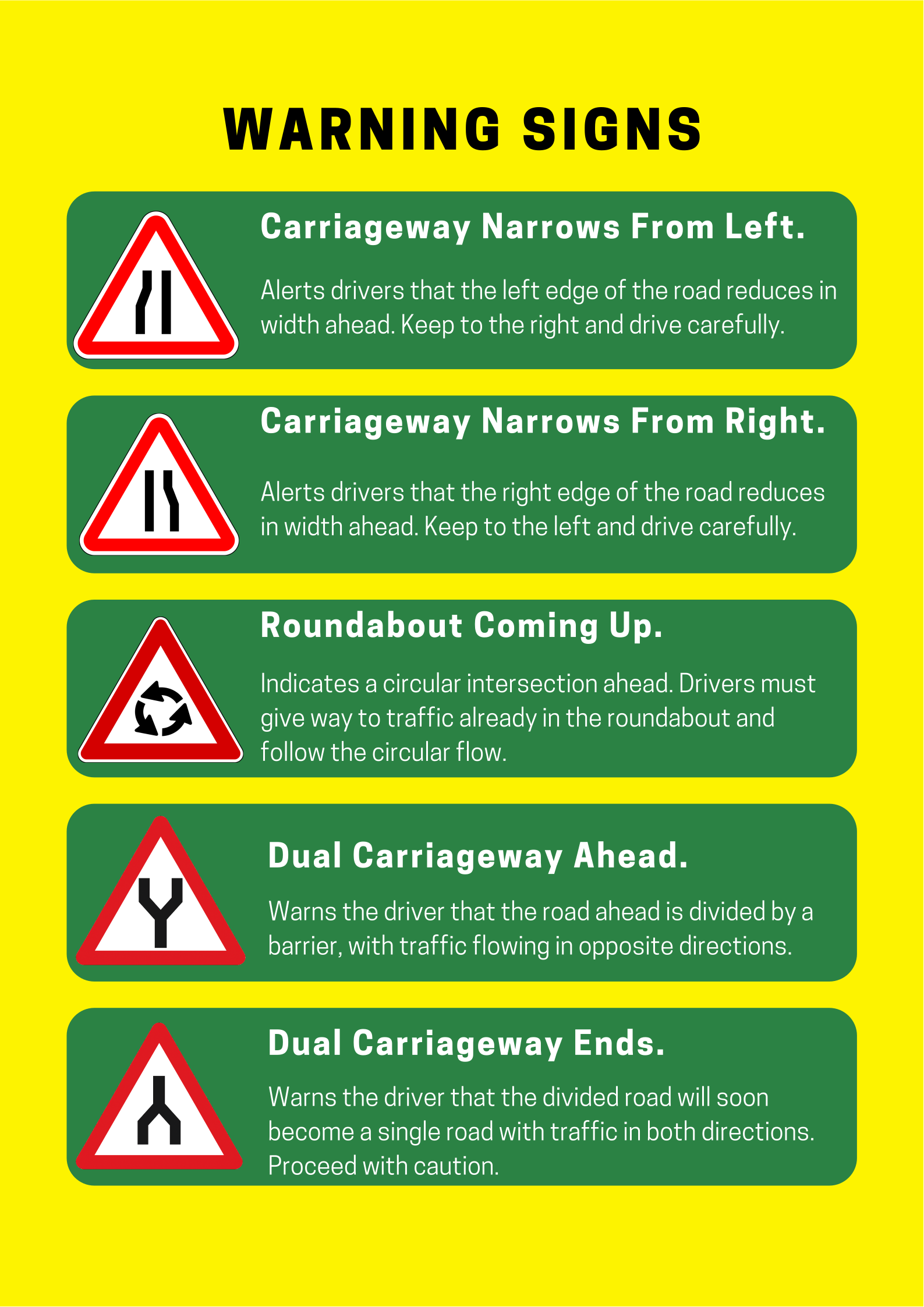Road Signs
Road signs are important symbols placed along the road to guide and protect all road users. They help drivers, cyclists, and pedestrians know what to do, where to go, and how to stay safe. Every sign has a meaning, and understanding them is very important for safe driving.
There are four main types of road signs you should know:
- Warning Signs – These alert you to dangers or changes in road conditions ahead.
- Prohibitory Signs – These tell you what is not allowed on the road.
- Mandatory Signs – These tell you what you must do, like directions you must follow.
- Informatory Signs – These give helpful information, like nearby hospitals or parking spots.
Always pay attention to road signs—they help save lives.
Instructions: Click on each section below to reveal the different types of road signs and their meanings. This will help you understand what each sign looks like and what it is telling drivers or pedestrians to do. Take your time to go through them one by one!
WARNING SIGNS
WARNING SIGNS
Warning signs are road signs used to alert drivers and other road users to potential hazards or changes in road conditions ahead. These signs are typically triangular with a red border and a white background, containing black symbols that represent the specific danger. Warning signs help ensure safety by giving drivers time to slow down, stay alert, and respond appropriately to upcoming situations such as sharp curves, steep hills, pedestrian crossings, slippery roads, or animal crossings. Recognizing and obeying warning signs is essential for preventing accidents and maintaining a smooth traffic flow, especially in unfamiliar or high-risk areas. Here are some commonly used warning signs in Ghana.
PROHIBITORY SIGNS
PROHIBITORY SIGNS
Prohibitory signs are traffic signs that inform road users of specific actions or types of vehicles that are not allowed. They are usually circular with a red border and a white background, displaying black symbols that clearly show what is prohibited. These signs are important for maintaining safety, order, and efficiency on the roads. Common prohibitory signs include “No entry,” “No overtaking,” “No U-turn,” and restrictions for certain vehicles like trucks or motorcycles. By following these signs, drivers help prevent conflicts, reduce congestion, and avoid penalties. Understanding prohibitory signs is crucial for safe and lawful driving.
Below are some of the most common prohibitory signs used in Ghana.
MANDATORY SIGNS
MANDATORY SIGNS
Mandatory signs are traffic signs that instruct drivers to take specific actions they must follow. These signs are typically circular with a blue background and white symbols, clearly indicating required movements or directions. They are used to ensure the orderly flow of traffic and enhance road safety. Examples include “Turn left,” “Keep right,” “Go straight only,” and “Route for cyclists only.” Unlike warning or prohibitory signs, mandatory signs do not give options — they dictate the exact action to take. Obeying these signs is essential for safe navigation and avoiding legal penalties or dangerous situations on the road. The following are popular mandatory signs typically seen in Ghana.
INFORMATORY SIGNS
INFORMATORY SIGNS
Informatory signs provide helpful guidance and general information to road users. They are usually rectangular and use symbols or text to convey directions, locations, or available facilities. These signs do not issue warnings or commands but help drivers make informed decisions during their journey. Common examples include signs for hospitals, parking areas, filling stations, and No Through Roads. Informatory signs contribute to convenience and smoother travel by pointing out essential services, route directions, and destinations. While they do not carry legal obligations like prohibitory or mandatory signs, paying attention to them improves navigation and overall driving experience. The following are popular Informatory signs typically seen in Ghana.
